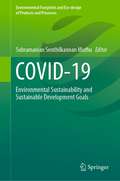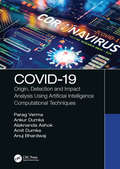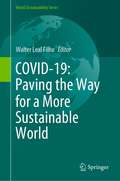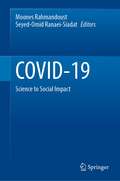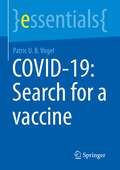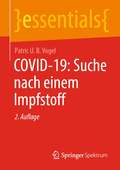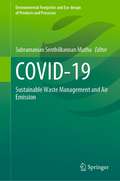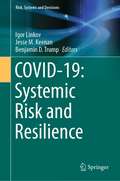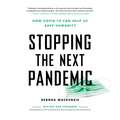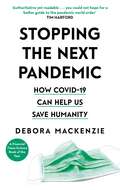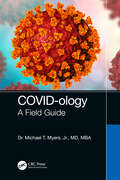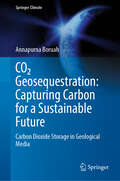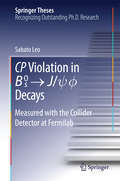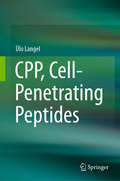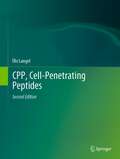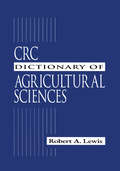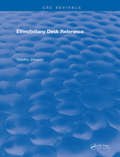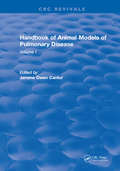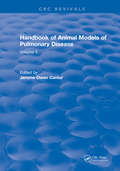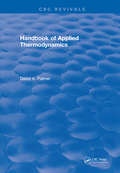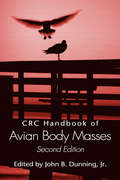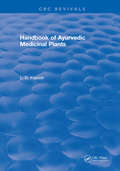- Table View
- List View
COVID-19: Environmental Sustainability and Sustainable Development Goals (Environmental Footprints and Eco-design of Products and Processes)
by Subramanian Senthilkannan MuthuThis book highlights the impact of COVID-19 on environmental sustainability and SDG’s, using various case studies. The year 2020 was a historical year mainly due to the pandemic caused by COVID-19 and it influenced or affected the global economy, business models and the industrial sectors, thus impacting sustainability in various ways. Given that sustainability has many faces and facets, it is worthwhile to deal with the relation (or impact) of COVID-19 on various elements of sustainability. This book presents how COVID-19 has influenced Environmental Sustainability along with the SDG’s.
COVID-19: Origin, Detection and Impact Analysis Using Artificial Intelligence Computational Techniques
by Ankur Dumka Alaknanda Ashok Parag Verma Amit Dumka Anuj BhardwajThis book highlights progress in terms of Virus Biology and Infection Detection, Prevention, and Control, along with Screening, Testing, and Detection Techniques, that will provide learners and researchers (from basic to advanced) with the most innovative computer-driven methodologies for the fight against COVID-19. In addition, this book also covers the Pre- and Post-Impact of the COVID-19 Pandemic Crisis that will definitely provide useful content for researchers to think broadly about the analytical areas affected by COVID-19. This ultimately shows different paths to the same destination to help understand the nature of the COVID-19 pandemic and how to avoid it in the future.
COVID-19: Paving the Way for a More Sustainable World (World Sustainability Series)
by Walter Leal FilhoThis book gathers and disseminates opinions, viewpoints, studies, forecasts, and practical projects which illustrate the various pathways sustainability research and practice may follow in the future, as the world recovers from the COVID-19 pandemic and prepares itself to the possibilities of having to cope with similar crisis, a product of the Inter-University Sustainable Development Research Programme (IUSDRP) https://www.haw-hamburg.de/en/ftz-nk/programmes/iusdrp.html and the European School of Sustainability Science and Research (ESSSR) https://esssr.eu/. The COVID-19 pandemic has led to severe human suffering, and to substantial damages to economies around the globe, affecting both rich countries and developing ones. The aftermath of the epidemic is also expected to be felt for sometime. This will also include a wide range of impacts in the ways sustainable development is perceived, and how the principles of sustainability are practised.There is now a pressing need to generate new literature on the connections between COVID-19 and sustainability. This is so for two main reasons. Firstly, the world crisis triggered by COVID-19 has severely damaged the world economy, worsening poverty, causing hardships, and endangering livelihoods. Together, these impacts may negatively influence the implementation of sustainable development as a whole, and of the UN Sustainable Development Goals in particular. These potential and expected impacts need to be better understood and quantified, hence providing a support basis for future recovery efforts. Secondly, the shutdown caused by COVID-19 has also been having a severe impact on teaching and research, especially –but not only – on matters related to sustainability. This may also open new opportunities (e.g. less travel, more Internet-based learning), which should be explored further, especially in the case of future pandemics, a scenario which cannot be excluded.The book meets these perceived needs.
COVID-19: Science to Social Impact
by Moones Rahmandoust Seyed-Omid Ranaei-SiadatThis book highlights the overview of the COVID-19 pandemic from both the scientific and the social perspectives. The scientific part presents key facts of COVID-19, including the structure of the virus and the techniques for the diagnosis, treatment, and vaccine development against the disease, covering state-of-the-art findings and achievements worldwide. The social part is written by WHO professionals who worked on the frontier of the fight against the disease. It covers the global security situation during the pandemic, the WHO and governmental-level risk management measures, and the estimated impact that COVID-19 will eventually create on social life after it is globally controlled.
COVID-19: Search for a vaccine (essentials)
by Patric U. VogelThis book presents the principle, strengths and weaknesses, and progress of various vaccine technologies against COVID-19. Additionally, important terms such as clinical phases, efficacy and sterilizing immunity are explained. In this second edition, the already approved vaccines are also presented and the importance of viral variants is explained
COVID-19: Suche nach einem Impfstoff (essentials)
by Patric U. VogelIn diesem Buch werden das Prinzip, die Stärken und Schwächen sowie der Fortschritt verschiedener Impfstofftechnologien gegen COVID-19 dargestellt. Es werden zusätzlich wichtige Begriffe wie klinische Phasen, Wirksamkeit und sterilisierende Immunität erklärt. In dieser zweiten Auflage werden auch die bereits zugelassenen Impfstoffe vorgestellt sowie die Bedeutung von Virusvarianten erklärt.
COVID-19: Sustainable Waste Management and Air Emission (Environmental Footprints and Eco-design of Products and Processes)
by Subramanian Senthilkannan MuthuThis book highlights the impact of COVID-19 on sustainable waste management and air emission, using various case studies. The year 2020 was a historical year mainly due to the pandemic caused by COVID-19 and it influenced or affected the global economy, business models and the industrial sectors, thus impacting sustainability in various ways. Given that sustainability has many faces and facets, it is worthwhile to deal with the relation (or impact) of COVID-19 on various elements of sustainability. This book presents how COVID-19 has influenced waste management and air quality.
COVID-19: Systemic Risk and Resilience (Risk, Systems and Decisions)
by Igor Linkov Jesse M. Keenan Benjamin D. TrumpThis book aims to provide a collection of early ideas regarding the results of applying risk and resilience tools and strategies to COVID-19. Each chapter provides a distinct contribution to the new and rapidly growing literature on the developing COVID-19 pandemic from the vantage points of fields ranging from civil and environmental engineering to public policy, from urban planning to economics, and from public health to systems theory. Contributing chapters to the book are both scholars and active practitioners, who are bridging their applied work with critical scholarly interpretation and reflection. The book's primary purpose is to empower stakeholders and decision-makers with the most recent research in order that they can better understand the systemic and sweeping nature of the COVID-19 pandemic, as well as which strategies could be implemented to maximize socioeconomic and public health recovery and adaptation over the long-term.
COVID-19: The Pandemic that Never Should Have Happened and How to Stop the Next One
by Debora MacKenzieIn a gripping, accessible narrative, a veteran science journalist lays out the shocking story of how the COVID-19 coronavirus pandemic happened and how to make sure this never happens againOver the last 30 years of epidemics and pandemics, we learned nearly every lesson needed to stop this coronavirus outbreak in its tracks. We heeded almost none of them. The result is a pandemic on a scale never before seen in our lifetimes. In this captivating, authoritative, and eye-opening book, science journalist Debora MacKenzie lays out the full story of how and why it happened: the previous viruses that should have prepared us, the shocking public health failures that paved the way, the failure to contain the outbreak, and most importantly, what we must do to prevent future pandemics.Debora MacKenzie has been reporting on emerging diseases for more than three decades, and she draws on that experience to explain how COVID-19 went from a potentially manageable outbreak to a global pandemic. Offering a compelling history of the most significant recent outbreaks, including SARS, MERS, H1N1, Zika, and Ebola, she gives a crash course in Epidemiology 101--how viruses spread and how pandemics end--and outlines the lessons we failed to learn from each past crisis. In vivid detail, she takes us through the arrival and spread of COVID-19, making clear the steps that governments knew they could have taken to prevent or at least prepare for this. Looking forward, MacKenzie makes a bold, optimistic argument: this pandemic might finally galvanize the world to take viruses seriously. Fighting this pandemic and preventing the next one will take political action of all kinds, globally, from governments, the scientific community, and individuals--but it is possible.No one has yet brought together our knowledge of COVID-19 in a comprehensive, informative, and accessible way. But that story can already be told, and Debora MacKenzie's urgent telling is required reading for these times and beyond. It is too early to say where the COVID-19 pandemic will go, but it is past time to talk about what went wrong and how we can do better.
COVID-19: The Pandemic that Never Should Have Happened, and How to Stop the Next One
by Debora MacKenzie'Excellent . . . analyses clearly and authoritatively how the coronavirus pandemic played out, what governments should have done, and what we need to do when it happens again - as it undoubtedly will' Financial Times'You could not hope for a better guide to the pandemic world order than Debora MacKenzie, who's been on this story from the start. This is an authoritative yet readable explanation of how this catastrophe happened - and more important, how it will happen again if we don't change'Tim Harford, author of The Undercover Economist, Adapt and Messy'This definitely deserves a read - the first of the post mortems by a writer who knows what she's talking about'Laura Spinney, author of Pale Rider: The Spanish Flu of 1918 and How It Changed the WorldIn a gripping, accessible narrative, a veteran science journalist lays out the shocking story of how the COVID-19 coronavirus pandemic happened and how to make sure this never happens againOver the last 30 years of epidemics and pandemics, we learned every lesson needed to stop this coronavirus outbreak in its tracks. We heeded almost none of them. The result is a pandemic on a scale never before seen in our lifetimes. In this captivating, authoritative, and eye-opening book, science journalist Debora MacKenzie lays out the full story of how and why it happened: the previous viruses that should have prepared us, the shocking public health failures that paved the way, the failure to contain the outbreak, and most importantly, what we must do to prevent future pandemics.Debora MacKenzie has been reporting on emerging diseases for more than three decades, and she draws on that experience to explain how COVID-19 went from a potentially manageable outbreak to a global pandemic. Offering a compelling history of the most significant recent outbreaks, including SARS, MERS, H1N1, Zika, and Ebola, she gives a crash course in Epidemiology 101--how viruses spread and how pandemics end--and outlines the lessons we failed to learn from each past crisis. In vivid detail, she takes us through the arrival and spread of COVID-19, making clear the steps that governments knew they could have taken to prevent or at least prepare for this. Looking forward, MacKenzie makes a bold, optimistic argument: this pandemic might finally galvanize the world to take viruses seriously. Fighting this pandemic and preventing the next one will take political action of all kinds, globally, from governments, the scientific community, and individuals--but it is possible.No one has yet brought together our knowledge of COVID-19 in a comprehensive, informative, and accessible way. But that story can already be told, and Debora MacKenzie's urgent telling is required reading for these times and beyond. It is too early to say where the COVID-19 pandemic will go, but it is past time to talk about what went wrong and how we can do better.
COVID-ology: A Field Guide
by Michael T. Myers, Jr.The COVID-19 outbreak and response has been characterized by institutional missteps, media misinformation, and economic and social upheavals. This book is intended to de-mystify and inform in a succinct and straightforward text. The lessons shared are applicable to other infectious diseases and future inevitable pandemics. Readers will learn about the origins of COVID-19, the disease it causes, tests and how they work, therapeutics and prophylactic measures such as vaccines. This text prepares readers to be better able to respond to future emerging infectious diseases and pandemics. Key Features Positively influences career choices within public health Applies basic science to problems raised by the COVID-19 pandemic such as vaccine development and herd immunity Prepares readers with context and tactics for understanding future infectious disease outbreaks Successfully used in college senior health sciences seminars Engaging and balanced treatment of the politicization of public health issues, especially COVID-19 Related Titles Goswami, S. & C. Day, eds. COVID-19 and SARS-CoV-2: The Science and Clinical Application of Conventional and Complimentary Treatments (ISBN 9781032011950). Koley, T. K. & M. Dhole. The COVID-19 Pandemic: The Deadly Coronavirus Outbreak (ISBN 9780367558895). Ryan, J. M., ed. COVID-19 – Two volume set (ISBN 9780367740610).
CO₂ Geosequestration: Carbon Dioxide Storage in Geological Media (Springer Climate)
by Annapurna BoruahAs the world faces the urgent need to combat climate change, "CO2 Geosequestration: Capturing Carbon for a Sustainable Future" provides a comprehensive solution on carbon dioxide storage in geological media, and utilization to reduce the CO2 from the atmosphere. This book serves as a guide to understanding the science and technology for carbon dioxide geosequestration. In this engaging guide, the author delves into innovative methods and processes designed to securely store CO2 emissions from various sources. With a focus on environmental sustainability, the book explores the geological storage of carbon dioxide in depleted oil and gas reservoirs, coal, shale, saline aquifers, basalt, and other underground formations, ensuring that this remains safely sequestered for the long term. Through a blend of real-world case studies, cutting-edge research, and expert insights, CO2 Geosequestration highlights the potential of this technology to mitigate greenhouse gas emissions and reduce the carbon footprint of industries worldwide. From the basics of carbon capture to the intricate details of monitoring and verification, this book offers an in-depth look at the challenges, opportunities, and prospects of CO2 geosequestration. Whether you are a scientist, engineer, policymaker, or environmentally conscious individual, this book provides a valuable resource for understanding the fundamental principles and potential benefits of geosequestration in the fight against climate change. Join us on a journey toward a sustainable future where carbon capture and geosequestration play critical roles in protecting our planet for generations to come.
CP Violation
by I. I. Bigi A. I. SandaWhy didn't the matter in our Universe annihilate with antimatter immediately after its creation? The study of CP violation may help to answer this fundamental question. This book presents theoretical tools necessary to understand this phenomenon. Reflecting the explosion of new results over the last decade, this second edition has been substantially expanded. It introduces charge conjugation, parity and time reversal, before describing the Kobayashi-Maskawa (KM) theory for CP violation and our understanding of CP violation in kaon decays. It reveals how the discovery of B mesons has provided a new laboratory to study CP violation with KM theory predicting large asymmetries, and discusses how these predictions have been confirmed since the first edition of this book. Later chapters describe the search for a new theory of nature's fundamental dynamics. This book is suitable for researchers in high energy, atomic and nuclear physics and the history and philosophy of science.
CP Violation in {B_s}^0 -> J/psi.phi Decays: Measured with the Collider Detector at Fermilab (Springer Theses)
by Sabato LeoThis thesis reports on the final measurement of the flavor-mixing phase in decays of strange-bottom mesons (B_s) into J/psi and phi mesons performed in high-energy proton-antiproton collisions recorded by the Collider Experiment at Fermilab. Interference occurs between direct decays and decays following virtual particle-antiparticle transitions (B_s-antiB_s). The phase difference between transition amplitudes ("mixing phase") is observable and extremely sensitive to contributions from non-standard-model particles or interactions that may be very hard to detect otherwise - a fact that makes the precise measurement of the B_s mixing phase one of the most important goals of particle physics. The results presented include a precise determination of the mixing phase and a suite of other important supplementary results. All measurements are among the most precise available from a single experiment and provide significantly improved constraints on the phenomenology of new particles and interactions.
CPO Focus on Physical Science
by Thomas C. HsuMiddle school science textbook, with many experiments and activities.
CPP, Cell-Penetrating Peptides
by Ülo LangelIn this book, a summary and update of the most important areas of CPP research are presented, whilst raising relevant questions for further development. The CPP sequences are presented and discussed throughout the book. The methods for testing CPP mechanisms are discussed in detail. Various approaches for the testing of endocytotic pathways of CPP uptake are also described. Different CPP uptake experiments are compared since it is becoming clear that it is often best to apply several methods in a complementary manner in order to most comprehensively evaluate CPP uptake mechanisms due to the complexity of these processes. A brief summary of functionality issues of CPPs, both in vitro and in vivo are discussed. Therapeutic potential of CPPs and commercial developments are discussed. The monograph is written for researchers and students in the field.
CPP, Cell-Penetrating Peptides
by Ülo LangelIn this book, a summary and update of the most important areas of cell-penetrating peptides (CPP) research are presented, while raising relevant questions for further development. The CPP sequences are presented and discussed throughout the book. The methods for testing CPP mechanisms are discussed in detail. Various approaches for the testing of endocytotic pathways of CPP uptake are also described. Different CPP uptake experiments are compared since it is becoming clear that it is often best to apply several methods in a complementary manner in order to most comprehensively evaluate CPP uptake mechanisms due to the complexity of these processes. A brief summary of functionality issues of CPPs, both in vitro and in vivo, is discussed. Therapeutic potential of CPPs and commercial developments are discussed. The present, second edition of this book is the updated and expanded version of the first edition, published in 2019. The development of the field of cell-penetrating peptides in these five years has been obvious and exciting. This second edition of the book has been partly reorganized and comprehensively expanded with the exciting research in 2019-2023. Around 2500 novel scientific articles have become available, most of them are reviewed in the second edition. Additional rapidly growing areas of high impact presented in this second edition are therapeutic developments (Chapter 16) and delivery of oligonucleotides and proteins/peptides (Chapters 5 and 6) including novel reports on genome editing with CPP assistance. Also, several additional examples are available now on clinical trials using CPPs (Chapter 15). The book is written for researchers and students in the field.
CRC Dictionary of Agricultural Sciences
by Robert Alan LewisThis dictionary includes every area of agriculture, from traditional farming to the latest techniques in biotechnology and genetics. The dictionary provides standardized definitions that establish common ground between the various types of practitioners involved in agriculture. It defines terminology in areas such as agricultural economics and business, agroecology, agronomy, animal science, aquaculture, botany, conservation, dairy science, entomology, food science, forestry, horticulture, natural resource management, and much more.
CRC Ethnobotany Desk Reference
by Tim JohnsonThe CRC Ethnobotany Desk Reference contains almost 30,000 concise ethnobotanical monographs of plant species characteristics and an inventory of claimed attributes and historical uses by cultures throughout the world-the most ambitious attempt to date to inventory plants on a global scale and match botanical information with historical and current uses.To obtain the same information about any species listed, you would have to thumb through hundreds of herbal guides, ethnobotanical manuals, and regional field guides. Sources for this index include the three largest U.S. Government ethnobotany databases, the U.S. National Park Service NPFlora plant inventory lists, and 18 leading works on the subject.
CRC Handbook of Animal Models of Pulmonary Disease: Volume I
by Jerome Owen CantorThis two-volume handbook provides important information concerning the development, implementation, evaluation, uses, advantages, and limitations of a wide variety of animal model of pulmonary disease. While the work focuses on stepwise procedures for inducing and quantifying disease, additional emphasis is placed on each model's relationship to human counterparts and on comparisons with similar models of injury. Thus, even the novice researcher will be able to more sharply define a particular research question, find suitable animal models for study, gain access to specialized techniques, and evaluate results within the context of an up-to-date body of information about related forms of lung diseases.
CRC Handbook of Animal Models of Pulmonary Disease: Volume II
by Jerome Owen CantorThis two-volume handbook provides important information concerning the development, implementation, evaluation, uses, advantages, and limitations of a wide variety of animal model of pulmonary disease. While the work focuses on stepwise procedures for inducing and quantifying disease, additional emphasis is placed on each model's relationship to human counterparts and on comparisons with similar models of injury. Thus, even the novice researcher will be able to more sharply define a particular research question, find suitable animal models for study, gain access to specialized techniques, and evaluate results within the context of an up-to-date body of information about related forms of lung diseases.
CRC Handbook of Applied Thermodynamics
by David A. PalmerThis practical handbook features an overview of the importance of physical properties and thermodynamics; and the use of thermo-dynamics to predict the extent of reaction in proposed new chem-ical combinations. The use of special types of data and pre-diction methods to develop flowsheets for probing projects; and sources of critically evaluated data, dividing the published works into three categories depending on quality are given. Methods of doing one's own critical evaluation of literature, a list of known North American contract experimentalists with the types of data mea-sured by each, methods for measuring equilibrium data, and ther-modynamic concepts to carry out process opti-mization are also featured.
CRC Handbook of Avian Body Masses
by John B. Dunning Jr.See what's new in the Second Edition: Number of species included is increased from 6300 to over 8700, about 85% of the world's birds Better data for many of the species included in the first edition- an exhaustive compilation of new data publis
CRC Handbook of Ayurvedic Medicinal Plants
by L. D. KapoorThis handbook is filled with over 50 illustrations and descriptions of approximately 250 plants which are used for herbal medicine. It includes the most current information available today on medicinal plants ranging from Abies spectabilis to Zizyphus vulgaris. The purpose of this handbook is to make available a reference for easy, accurate identification of these herbs. Derived from India, "Ayurveda" is the foundation stone of their ancient medical science. Approximately 80 percent of the population of India and other countries in the East continue to utilize this system of medicinal treatment. It is believed that the key to successful medication is the use of the correct herb. This is an indispensable resource for all physicians, pharmacists, drug collectors, and those interested in the healing art.
